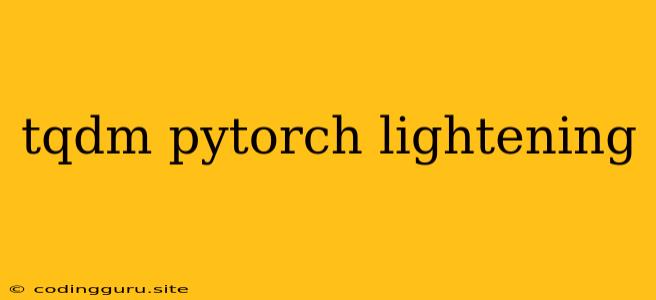Harnessing the Power of tqdm and PyTorch Lightning for Efficient Deep Learning Training
Deep learning models can take a considerable amount of time to train, especially as the complexity of the model and the size of the dataset increase. This can be frustrating and make it challenging to track the progress of your training process. Fortunately, there are tools that can help alleviate this pain point. tqdm and PyTorch Lightning are two such tools that can significantly improve the efficiency and clarity of your deep learning training.
What is tqdm?
tqdm is a Python library that provides a progress bar for iterable objects. It is a powerful tool for visualizing the progress of long-running processes, providing a clear visual indication of how far along the training process is. This can be extremely helpful for understanding how long your training might take and keeping track of its progress.
Here's how to use tqdm:
from tqdm import tqdm
for i in tqdm(range(100)):
# Your training logic goes here
pass
In this example, tqdm will create a progress bar that updates as the loop iterates through the range of 100. tqdm automatically estimates the time remaining based on the current progress, providing even more valuable information.
What is PyTorch Lightning?
PyTorch Lightning is a high-level library that simplifies the process of training deep learning models using PyTorch. It encapsulates the common boilerplate code for training loops, data loading, and model optimization, allowing you to focus on the specific aspects of your model and training process. PyTorch Lightning provides a more structured and organized way to define and train your models, leading to more efficient code and making it easier to experiment with different architectures and training strategies.
Here's an example of how to use PyTorch Lightning:
import pytorch_lightning as pl
from pytorch_lightning.core.lightning import LightningModule
class MyModel(LightningModule):
def __init__(self, *args, **kwargs):
super().__init__()
# Define your model architecture here
def forward(self, x):
# Your forward pass logic
def configure_optimizers(self):
# Define your optimizer and learning rate scheduler
def training_step(self, batch, batch_idx):
# Your training step logic
def validation_step(self, batch, batch_idx):
# Your validation step logic
def test_step(self, batch, batch_idx):
# Your test step logic
model = MyModel()
trainer = pl.Trainer()
trainer.fit(model)
This simple example demonstrates the basic structure of a PyTorch Lightning model. You define your model architecture, optimizer, and training, validation, and test steps. PyTorch Lightning takes care of the rest, including setting up the training loop and logging results.
Combining tqdm and PyTorch Lightning
You can combine the power of tqdm and PyTorch Lightning to achieve even more efficient and informative deep learning training. PyTorch Lightning already provides progress bars for training, validation, and testing, but tqdm can be used to add more granular progress tracking for specific parts of your training loop, such as data loading or specific training steps.
Here's how to use tqdm with PyTorch Lightning:
import pytorch_lightning as pl
from pytorch_lightning.core.lightning import LightningModule
from tqdm import tqdm
class MyModel(LightningModule):
# ... (Your model code)
def training_step(self, batch, batch_idx):
# Your training logic
for i in tqdm(range(10)):
# Perform specific training operations
loss = self.calculate_loss(batch)
return {'loss': loss}
model = MyModel()
trainer = pl.Trainer()
trainer.fit(model)
In this example, we've added a tqdm progress bar inside the training_step to track the progress of specific operations within the training step. This allows you to see how long each part of the training step takes, providing deeper insights into the training process.
Advantages of using tqdm and PyTorch Lightning
- Improved Visibility: tqdm provides clear visual feedback on the progress of your training, allowing you to easily track the time remaining and understand the current state of your model.
- Efficiency: PyTorch Lightning streamlines your training process, reducing boilerplate code and allowing you to focus on your model and training logic.
- Modular Structure: PyTorch Lightning encourages a more modular and organized approach to training, making it easier to experiment with different configurations and training strategies.
- Enhanced Debugging: tqdm progress bars help you identify potential bottlenecks in your training process, making it easier to debug and optimize your code.
Conclusion
tqdm and PyTorch Lightning are powerful tools that can significantly improve the efficiency and clarity of your deep learning training. By providing visual feedback on training progress, simplifying training code, and offering a more modular approach, these tools can save you time and effort, allowing you to focus on building and improving your models. The combination of these two libraries will allow you to train your models more efficiently and effectively, unlocking the full potential of your deep learning projects.
